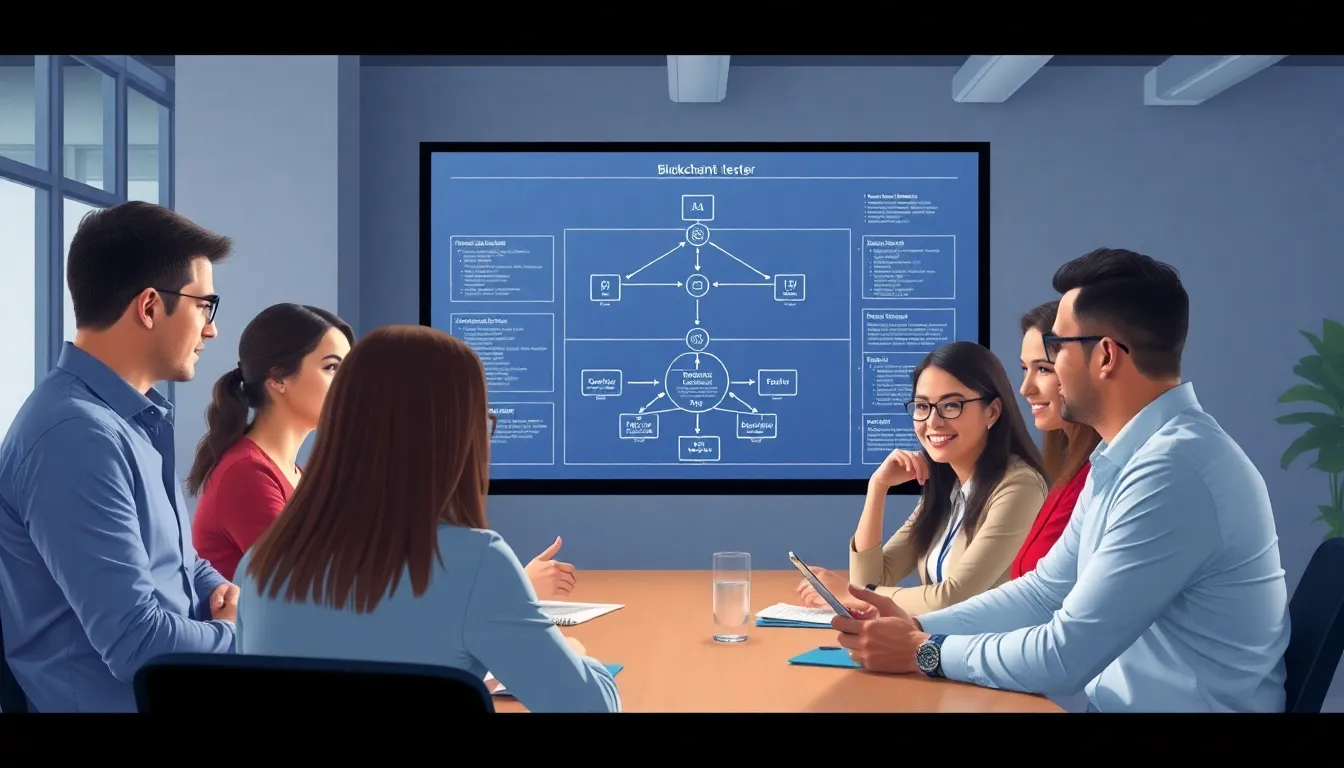Table of Contents
ToggleBlockchain isn’t just a buzzword tossed around in tech circles; it’s the digital equivalent of a Swiss Army knife, packed with tools that can revolutionize industries. Imagine a world where transactions are secure, transparent, and as unchangeable as your grandma’s secret cookie recipe. Building a blockchain might sound like a daunting task, but it’s more accessible than a late-night pizza delivery.
Understanding Blockchain Technology
Blockchain technology fundamentally transforms how digital information is stored and shared. It creates a decentralized and secure method for transactions across various industries.
What Is Blockchain?
Blockchain refers to a distributed ledger technology that records transactions across numerous computers. Each transaction forms a block, and these blocks are linked together chronologically. This linkage ensures that once data gets recorded, it remains immutable and secure from tampering. Decentralization underpins blockchain’s functionality, eliminating the need for a central authority. Examples include Bitcoin and Ethereum, which showcase how blockchain operates in practice.
Key Components of Blockchain
Key components of blockchain include blocks, nodes, and miners. Each block holds transaction data along with a unique identifier called a hash. Nodes consist of the network participants that validate and store copies of the blockchain. Miners play a crucial role by solving complex mathematical problems to add new blocks to the chain. Together, these components ensure the integrity, transparency, and security of the entire blockchain system.
Steps to Build Blockchain

Building a blockchain involves several key stages that ensure its functionality and efficiency. Each step focuses on a critical aspect of the blockchain creation process.
Defining Your Blockchain Purpose
Defining the blockchain’s purpose shapes its development and application. Identify the specific problems it addresses, whether it’s enhancing supply chain transparency or improving financial transactions. A solid understanding of the target users and their needs streamlines the design process. Market analysis demonstrates potential use cases, guiding decisions on necessary features. Documenting these goals aids in aligning the blockchain’s technical components with its intended functionality.
Choosing the Right Consensus Algorithm
Choosing the right consensus algorithm impacts how transactions are validated and added to the blockchain. Various options exist, including Proof of Work, Proof of Stake, and Delegated Proof of Stake, each with unique characteristics. Evaluate the security, scalability, and energy efficiency of each algorithm before making a selection. The consensus mechanism must align with the blockchain’s goals and the expected number of transactions. Developers benefit from understanding trade-offs between decentralization and efficiency when choosing an algorithm.
Designing the Blockchain Architecture
Designing the blockchain architecture entails mapping out the technical framework and components. Different layers, including the network layer and data layer, require consideration to facilitate seamless interactions among nodes. Carefully consider how users will interact with the blockchain, whether through a web interface or mobile application. Robust security protocols must also be integrated to protect data and maintain integrity. Documenting the architecture ensures smooth collaboration among team members and stakeholders.
Tools and Technologies for Building Blockchain
Various tools and technologies play a crucial role in building blockchain. Understanding these components enhances the development process.
Programming Languages for Blockchain Development
Smart contracts and transaction protocols rely on specific programming languages. Solidity stands out as a popular choice for Ethereum development. JavaScript offers versatility in building decentralized applications. Python supports rapid development and prototyping, while Go enhances performance in backend systems. C++ enables low-level memory manipulation, making it suitable for blockchain core development. Rust is favored for its safety and concurrency features. Each language contributes unique advantages tailored to specific blockchain requirements.
Frameworks and Platforms to Consider
Several frameworks expedite blockchain development. Hyperledger Fabric provides a modular architecture, ideal for enterprise solutions. Ethereum simplifies the creation of decentralized applications through its robust toolset. Corda focuses on financial services, enabling secure asset transactions. Quorum enhances Ethereum’s private transactions for businesses. Multichain allows quick deployment of private blockchains. Analyzing platform features ensures alignment with project goals and technical requirements. Each framework facilitates streamlined development processes, empowering teams to build efficient blockchain solutions.
Testing and Deployment
Thorough testing and strategic deployment are critical for successful blockchain applications. These stages confirm that the solution functions as intended and meets user expectations.
Testing Your Blockchain Solution
Testing validates the performance and security of a blockchain solution. Unit tests focus on individual components, ensuring each functions correctly. Integration tests confirm that different parts of the blockchain work cohesively. Furthermore, stress tests assess how the system performs under high transaction loads. Debugging tools aid in identifying issues during these processes, and continuous integration practices streamline the testing lifecycle, enabling quicker identification of potential software flaws. While these steps may seem tedious, they fortify the system against future vulnerabilities.
Launching and Maintaining Your Blockchain
Launching a blockchain requires a comprehensive strategy. Careful preparation helps ensure a smooth rollout. First, teams train users and provide adequate documentation to facilitate adoption. Additionally, ongoing maintenance is essential for combating potential issues post-launch. Regular updates, security audits, and performance optimizations contribute to the longevity of the system. Establishing user feedback channels also assists in identifying areas for improvement. Following these practices can extend the effectiveness and reliability of the blockchain over time.
Building a blockchain is an exciting journey that opens up a world of possibilities. With the right approach and understanding of essential components and technologies, anyone can embark on this transformative venture.
By focusing on purpose-driven design and leveraging appropriate tools, developers can create robust and secure blockchain solutions. The importance of thorough testing and strategic deployment cannot be overstated, as these steps ensure a reliable end product.
As blockchain technology continues to evolve, staying informed and adaptable will be key to harnessing its full potential. Embracing this innovation could lead to significant advancements across various industries, paving the way for a more decentralized future.







